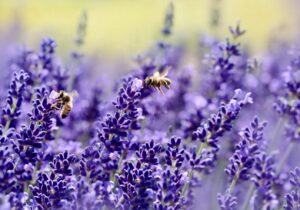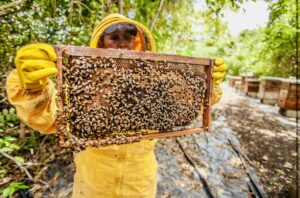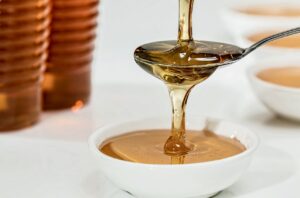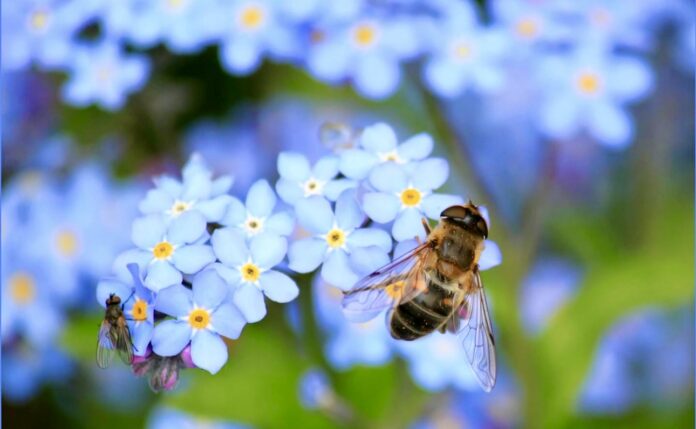Caro Lettore di Fairness Magazine, nel vasto panorama dell’ecosistema globale esiste un gruppo di creature così piccole ma così vitali che il loro ruolo non può essere sottovalutato: le api. Proprio come un veterinario dedica la propria carriera al benessere degli animali domestici e selvatici, vogliamo concentrare la nostra attenzione sulle api, quegli insetti piccoli che svolgono un ruolo straordinario nel sostenere il nostro pianeta.
Fairness Magazine, come ben sapete, è molto attenta all’ambiente e a tutte le creature, grandi e piccole, che sono affascinanti ed essenziali per la biodiversità globale. Sebbene possano sembrare insignificanti rispetto a molte delle specie animali con cui entriamo in contatto quotidianamente, le api svolgono un lavoro titanico nell’impollinare le piante, garantendo la produzione di frutta, verdura e persino molti dei fiori che adornano i nostri giardini. Come veterinari del nostro ecosistema, dobbiamo capire l’importanza cruciale di queste piccole creature e il loro impatto positivo sul nostro mondo.

Sfortunatamente, le api sono spesso sottovalutate e talvolta minacciate da fattori come il cambiamento climatico, l’inquinamento e la perdita di habitat. Ma il loro ruolo di impollinatori è essenziale per la sopravvivenza di numerose specie vegetali e, di conseguenza, per la nostra stessa sopravvivenza. Insieme, esploreremo il mondo affascinante delle api, evidenziando il loro ruolo nell’ecosistema globale e le sfide che affrontano.
Unisciti a noi in questa esplorazione delle api, vitali per la salute del nostro pianeta e per il benessere di tutte le creature che lo abitano. Insieme, possiamo lavorare per preservare e proteggere questi piccoli ma potenti custodi della natura.
Le api, quegli instancabili insetti ronzanti tra i fiori, sono spesso sottovalutate quando si parla di biodiversità e sostenibilità ambientale. Tuttavia, l’importanza delle api nell’ecosistema è immeasurabile e merita un’attenta esaminazione… L’importanza ambientale delle api risiede nel loro cruciale ruolo di impollinatori. Senza di loro, la produzione alimentare globale sarebbe gravemente compromessa. Le api contribuiscono alla produzione di frutta, verdura, noci e altri alimenti che sono parte fondamentale della nostra dieta quotidiana. Inoltre, molte piante selvatiche dipendono dalle api per la loro riproduzione.
Le api svolgono un ruolo insostituibile nella conservazione degli ecosistemi e nella produzione alimentare globale, ed è essenziale riconoscerne il valore e, soprattutto, impegnarsi per la loro protezione. L’ape italiana, e le varie specie di api in tutto il mondo, sono custodi ambientali, e il loro benessere è strettamente legato al nostro. La loro importanza va ben oltre la produzione di miele, rappresentando un pilastro vitale della biodiversità e dell’equilibrio ambientale.
Le api, appartenenti all’ordine degli Imenotteri, variano in lunghezza da 12 a 20 millimetri e possono vivere da 30 giorni a 5 anni. La loro anatomia è divisa in tre parti principali: la testa, il torace e l’addome. La testa è dotata di due antenne sensibili che permettono alle api di percepire oggetti e sapori, mentre il nettare dei fiori viene assaggiato con la bocca. Il torace è dove si trovano le ali e le sei zampe, consentendo loro di raccogliere prezioso polline. Infine, l’addome ospita il pungiglione, utilizzato solo per difendere la colonia o se stesse.
Le api non sono solo incaricate di raccogliere nettare di fiore in fiore, ma sono anche insetti sociali che vivono in colonie molto grandi. La loro società è significativamente diversa da quella di altri insetti sociali come le formiche, poiché è caratterizzata da una straordinaria perfezione e laboriosità. All’interno di una colonia di api, gli individui sono profondamente connessi tra loro, e ogni ape è disposta a sacrificare la propria vita per la sopravvivenza della comunità.
Le arnie, le case delle colonie di api, sono composte da favi, straordinarie costruzioni di cera d’api divise in piccole celle esagonali. In Italia, la specie più diffusa è l’Apis Mellifera Ligustica, comunemente conosciuta come ape italiana. Questa specie è particolarmente produttiva e docile, ed è molto apprezzata in tutto il mondo per la sua capacità di produrre miele di alta qualità.

Oltre all’ape italiana, ci sono molte altre specie di api che svolgono un ruolo fondamentale nell’ecosistema globale. Alcune di esse sono:
Apis Mellifera – Conosciuta come l’ape europea, è una delle specie più comuni al mondo e svolge un ruolo chiave nell’impollinazione di una vasta gamma di piante.
Apis Dorsata – Questa gigantesca specie di ape è originaria dell’Asia ed è nota per le sue arnie aperte, appese alla cima degli alberi.
Apis Cerana – Comune in Asia, è essenziale per l’impollinazione dei raccolti di riso.
Bombus spp. – Conosciute come bombolette, queste api pelose svolgono un ruolo cruciale nell’impollinazione di piante da frutto e verdura.
Meliponini – Le api senza pungiglione appartenenti a questa tribù sono diffuse nelle regioni tropicali e contribuiscono all’impollinazione di molte piante endemiche.
Quando si tratta di api, si apre un mondo affascinante che va ben oltre la loro biologia affascinante. Le api, queste deliziose creature, non solo svolgono un ruolo vitale nell’impollinazione e nella conservazione degli ecosistemi, ma ci regalano anche una delizia dorata che è apprezzata in tutto il mondo: il miele.
Il Mondo Segreto delle Api: Le api sono insetti straordinariamente laboriosi che raccoglieranno senza sosta il nettare dai fiori e lo trasformeranno in miele. Questo prezioso liquido non è solo un dolcificante naturale ma è anche ricco di benefici per la salute, grazie alle sue proprietà antimicrobiche e antiossidanti. Le api lavorano insieme in una colonia altamente organizzata, con una gerarchia ben definita, per garantire la sopravvivenza della comunità.
All’interno della colonia, le api si impegnano in varie attività. Le operaie raccolgono nettare e polline, mentre le api maschi, conosciute come fuchi, e l’ape regina sono coinvolti nella riproduzione. Il risultato di questo lavoro laborioso è una delizia nota come miele, che può variare notevolmente nel sapore, nel colore e nella consistenza a seconda della specie di api e dei fiori da cui proviene.
La Diversità dei Miele Naturali: Sapevate che la varietà di mieli prodotti dalle api in tutto il mondo è semplicemente straordinaria? Beh, ogni tipo di miele ha un sapore unico e proprietà, con le sue caratteristiche e con i suoi molteplici benefici. Di seguito una breve guida esplorativa a alcune delle varietà di miele più conosciute al mondo:
Miele di Acacia – Con il suo sapore delicato e la consistenza leggera, il miele di acacia è uno dei preferiti tra i conoscitori. È ideale per dolcificare tè e caffè.
Miele di Manuka – Prodotta dalle api che si nutrono del nettare del manuka, un arbusto neozelandese, questo miele è noto per le sue proprietà antibatteriche e antinfiammatorie.
Miele di Lavanda – Con il suo distintivo aroma floreale, il miele di lavanda è perfetto per aromatizzare yogurt, formaggi e dolci.
Miele di Fiori di Campo – Questo miele varia a seconda dei fiori presenti nella zona in cui le api raccolgono il nettare, creando una miscela unica di sapori.
Miele di Castagno – Con un sapore deciso e un colore scuro, il miele di castagno è ottimo per accompagnare formaggi stagionati.
Miele di Eucalipto – Con un leggero sapore mentolato, questo miele è ampiamente utilizzato per lenire mal di gola e come ingrediente in molti prodotti per la cura del corpo.
Miele di Tamarindo – Originario dell’Asia, questo miele ha un sapore dolce e aspro distintivo ed è spesso usato nella cucina asiatica.
Miele di Fiori d’Arancio – Con il suo sapore fruttato e agrumato, il miele di fiori d’arancio è un perfetto accompagnamento per dolci e dessert.

Ig – @fairness_mag




